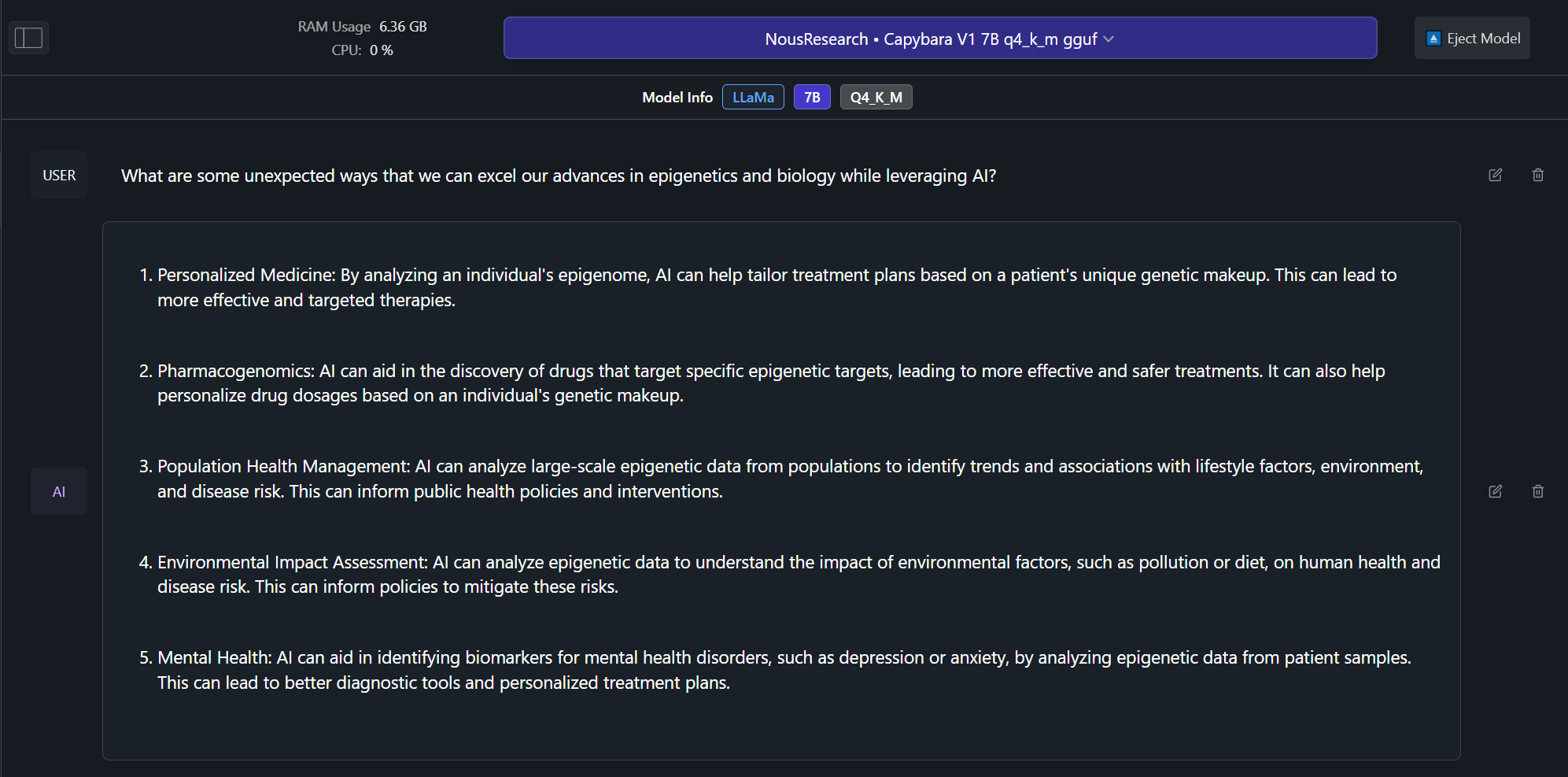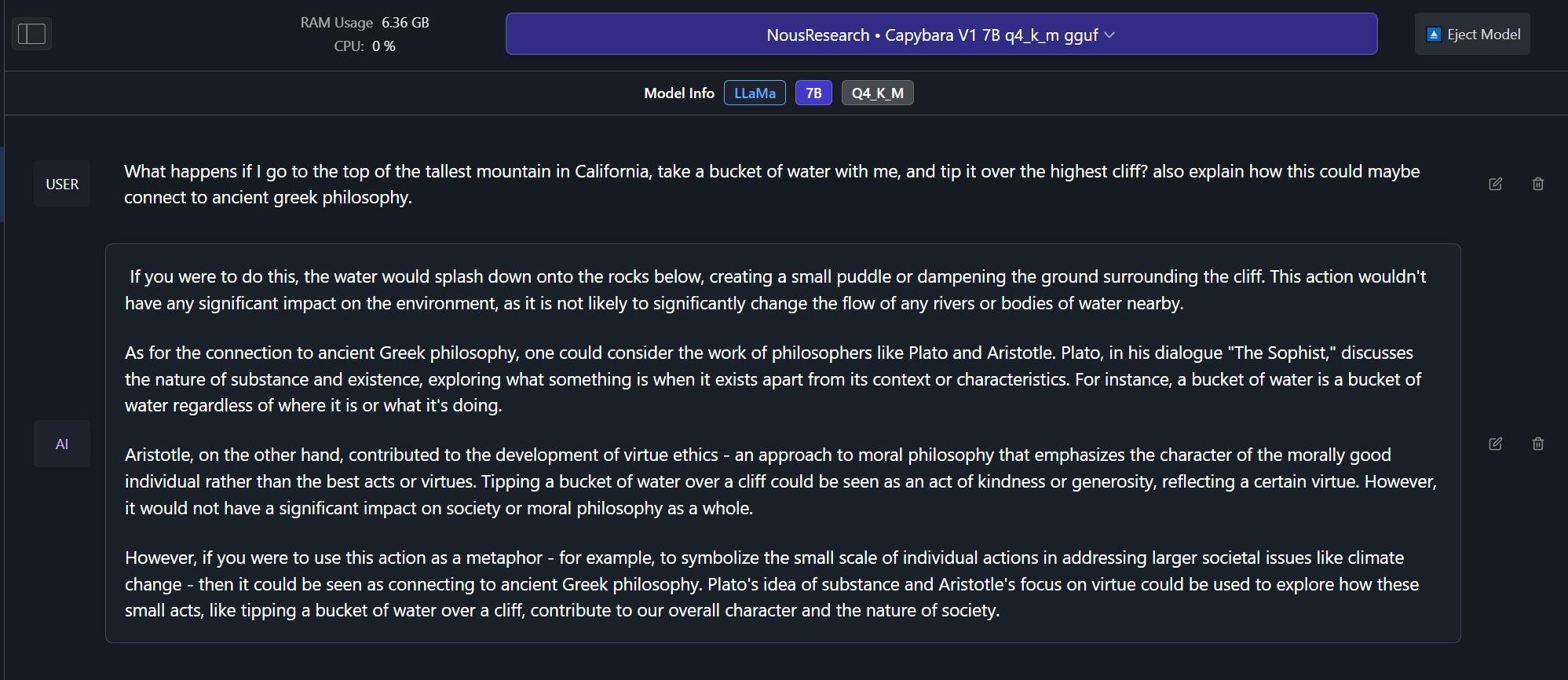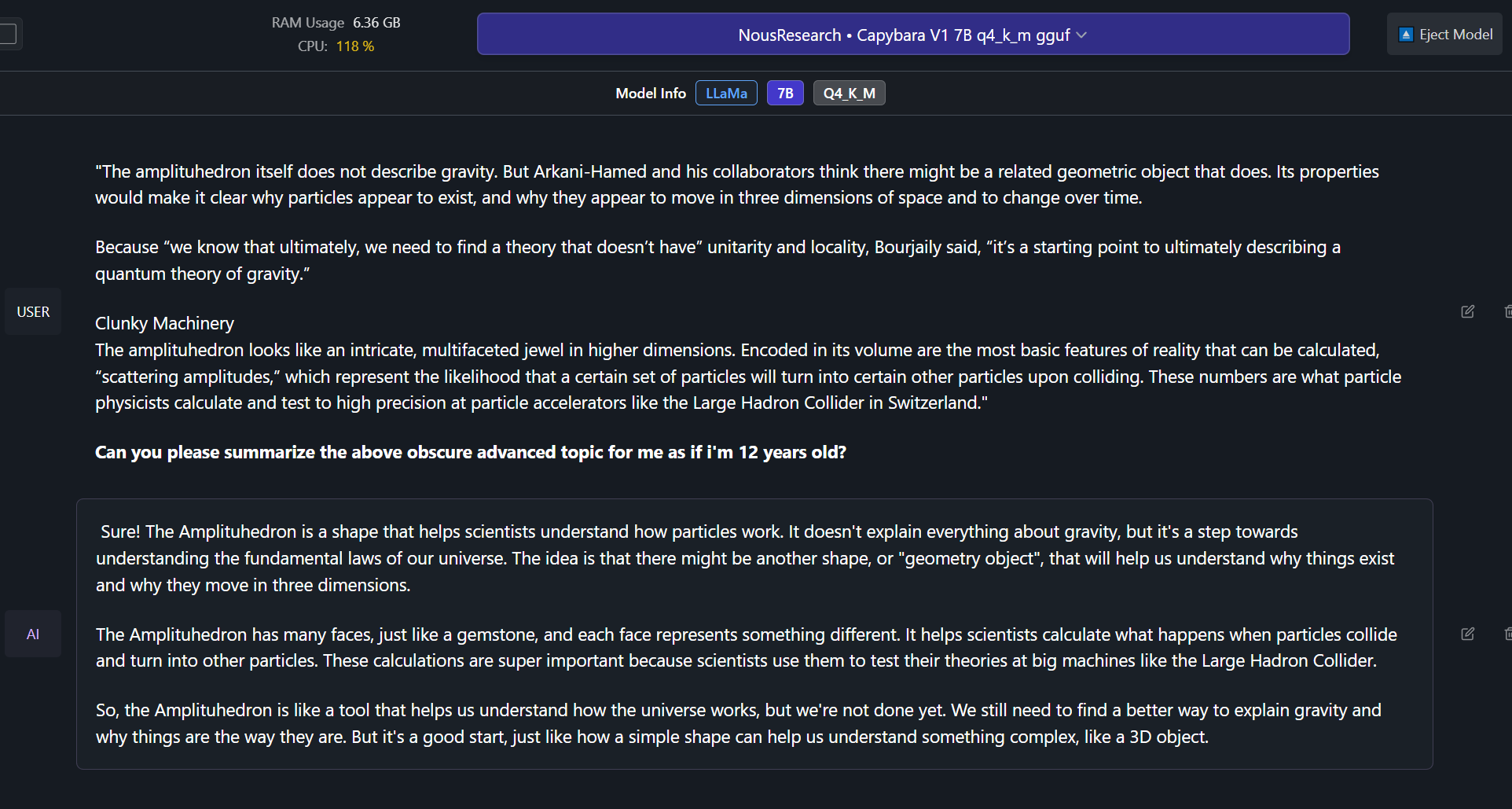I'm constantly enhancing these model descriptions to provide you with the most relevant and comprehensive information
Nous-Capybara-3B-V1.9 - GGUF
- Model creator: NousResearch
- Original model: Nous-Capybara-3B-V1.9
StableLM
This is a Model based on StableLM. Stablelm is a familiy of Language Models by Stability AI.
Note:
Current (as of 2023-11-15) implementations of Llama.cpp only support GPU offloading up to 34 Layers with these StableLM Models. The model will crash immediately if -ngl is larger than 34. The model works fine however without any gpu acceleration.
About GGUF format
gguf is the current file format used by the ggml library.
A growing list of Software is using it and can therefore use this model.
The core project making use of the ggml library is the llama.cpp project by Georgi Gerganov
Quantization variants
There is a bunch of quantized files available to cater to your specific needs. Here's how to choose the best option for you:
Legacy quants
Q4_0, Q4_1, Q5_0, Q5_1 and Q8 are legacy quantization types.
Nevertheless, they are fully supported, as there are several circumstances that cause certain model not to be compatible with the modern K-quants.
Note:
Now there's a new option to use K-quants even for previously 'incompatible' models, although this involves some fallback solution that makes them not real K-quants. More details can be found in affected model descriptions. (This mainly refers to Falcon 7b and Starcoder models)
K-quants
K-quants are designed with the idea that different levels of quantization in specific parts of the model can optimize performance, file size, and memory load. So, if possible, use K-quants. With a Q6_K, you'll likely find it challenging to discern a quality difference from the original model - ask your model two times the same question and you may encounter bigger quality differences.
Original Model Card:
Nous-Capybara-3B V1.9
The Capybara series is the first Nous collection of dataset and models made by fine-tuning mostly on data created by Nous in-house.
We leverage our novel data synthesis technique called Amplify-instruct (Paper coming soon), the seed distribution and synthesis method are comprised of a synergistic combination of top performing existing data synthesis techniques and distributions used for SOTA models such as Airoboros, Evol-Instruct(WizardLM), Orca, Vicuna, Know_Logic, Lamini, FLASK and others, all into one lean holistically formed methodology for the dataset and model. The seed instructions used for the start of synthesized conversations are largely based on highly datasets like Airoboros, Know logic, EverythingLM, GPTeacher and even entirely new seed instructions derived from posts on the website LessWrong, as well as being supplemented with certain in-house multi-turn datasets like Dove(A successor to Puffin).
While performing great in it's current state, the current dataset used for fine-tuning is entirely contained within 20K training examples, this is 10 times smaller than many similar performing current models, this is signficant when it comes to scaling implications for our next generation of models once we scale our novel syntheiss methods to significantly more examples.
Process of creation and special thank yous!
This model was fine-tuned by Nous Research as part of the Capybara/Amplify-Instruct project led by Luigi D.(LDJ) (Paper coming soon), as well as significant dataset formation contributions by J-Supha and general compute and experimentation management by Jeffrey Q. during ablations.
Special thank you to A16Z for sponsoring our training, as well as Yield Protocol for their support in financially sponsoring resources during the R&D of this project.
Thank you to those of you that have indirectly contributed!
While most of the tokens within Capybara are newly synthsized and part of datasets like Puffin/Dove, we would like to credit the single-turn datasets we leveraged as seeds that are used to generate the multi-turn data as part of the Amplify-Instruct synthesis.
The datasets shown in green below are datasets that we sampled from to curate seeds that are used during Amplify-Instruct synthesis for this project.
Datasets in Blue are in-house curations that previously existed prior to Capybara.
Model Training
Nous-Capybara 3B V1.9 is a new model trained for multiple epochs on a dataset of roughly 20,000 carefully curated conversational examples, most of which are comprised of entirely new in-house synthesized tokens.
Additional data came from human curated CamelAI data, with the help of volunteers ranging from former Physics PhD's, Mathematicians, Biologists and more!
Prompt Format
The model follows ChatML prompt format
<|im_start|>system
You are a helpful AI assistant.<|im_end|>
<|im_start|>user
How are you<|im_end|>
<|im_start|>assistant
I am doing well!<|im_end|>
Mutli-Modality!
- We currently have a Multi-modal model based on Capybara-3B-V1.9 ! https://huggingface.co/NousResearch/Obsidian-3B-V0.5
Notable Features:
Over 60% of the dataset is comprised of multi-turn conversations.(Most models are still only trained for single-turn conversations and no back and forths!)
Over 1,000 tokens average per conversation example! (Most models are trained on conversation data that is less than 300 tokens per example.)
Able to effectively do complex summaries of advanced topics and studies. (trained on hundreds of advanced difficult summary tasks developed in-house)
Ability to recall information upto late 2022 without internet.
Includes a portion of conversational data synthesized from less wrong posts, discussing very in-depth details and philosophies about the nature of reality, reasoning, rationality, self-improvement and related concepts.
Example Outputs!:
Benchmarks! (Coming soon!)
Future Changes
This is a relatively early build amongst the grand plans for the future of Capybara!
Future model sizes
Capybara V1.9 now currently has a 3B ad 7B size, and we plan to eventually have a 13B and 70B version in the future, as well as a potential 1B version based on phi-1.5 or Tiny Llama.
How you can help!
In the near future we plan on leveraging the help of domain specific expert volunteers to eliminate any mathematically/verifiably incorrect answers from our training curations.
If you have at-least a bachelors in mathematics, physics, biology or chemistry and would like to volunteer even just 30 minutes of your expertise time, please contact LDJ on discord!
Dataset contamination.
We have checked the capybara dataset for contamination for several of the most popular datasets and can confirm that there is no contaminaton found.
We leveraged minhash to check for 100%, 99%, 98% and 97% similarity matches between our data and the questions and answers in benchmarks, we found no exact matches, nor did we find any matches down to the 97% similarity level.
The following are benchmarks we checked for contamination against our dataset:
HumanEval
AGIEval
TruthfulQA
MMLU
GPT4All
End of original Model File
Please consider to support my work
Coming Soon: I'm in the process of launching a sponsorship/crowdfunding campaign for my work. I'm evaluating Kickstarter, Patreon, or the new GitHub Sponsors platform, and I am hoping for some support and contribution to the continued availability of these kind of models. Your support will enable me to provide even more valuable resources and maintain the models you rely on. Your patience and ongoing support are greatly appreciated as I work to make this page an even more valuable resource for the community.
- Downloads last month
- 550









